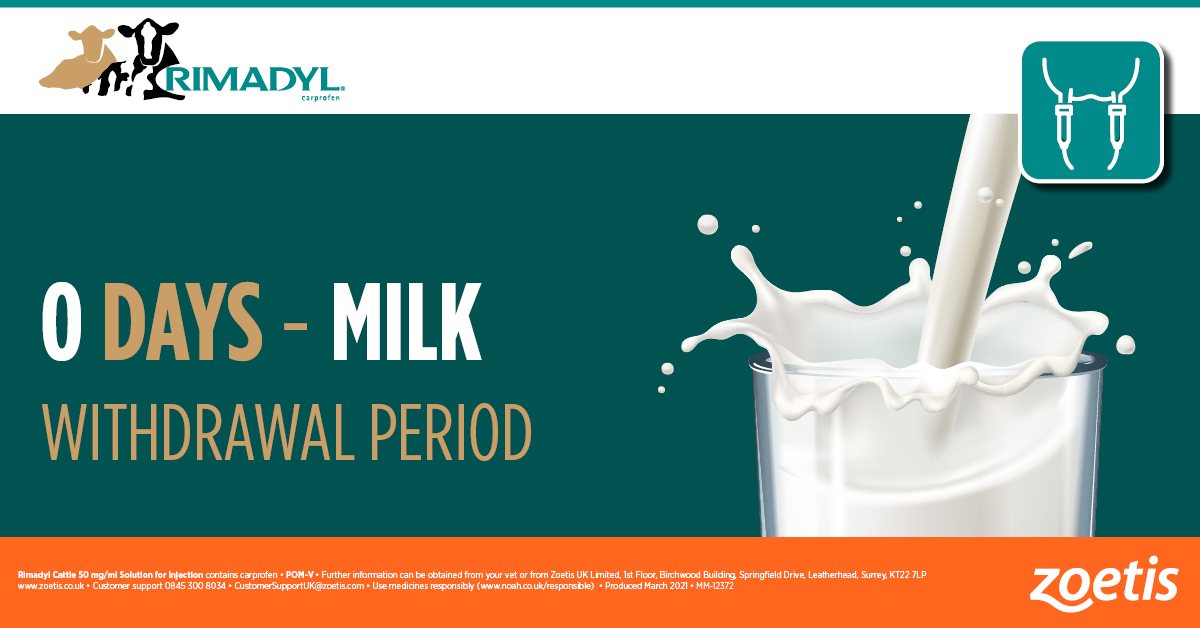NSAID with ZERO MILK WITHDRAWAL
Rimadyl® Cattle 50 mg/ml Solution for Injection
- A member of the 2-arylpropionic acid group of NSAIDs, Rimadyl® Cattle possesses anti-inflammatory, analgesic and antipyretic activity
- Proven efficacy in reducing clinical signs of acute mastitis and acute infectious respiratory disease*
- For mastitis - significantly reduces fever and quarter swelling1 and improves heart rate and rumen function
- For respiratory disease - significantly reduces fever and the inflammatory response in lung tissue
- Trialled during clinical studies alongside macrolides, tetracyclines, cephalosporins and potentiated penicillins without known drug interactions
- Low volume dose of 1mL/35kg given either SC or IV for added convenience
- Plasma elimination half-life of 70 hours
- 21-day meat withdrawal
PRESENTATION
Rimadyl Cattle is a clear, pale straw coloured solution for injection. Each ml contains 50 mg carprofen. Also contains 0.1 ml/ml ethanol and 10 mg/ml benzyl alcohol as preservatives.USES
Rimadyl Cattle is indicated as an adjunct to antimicrobial therapy to reduce clinical signs in acute infectious respiratory disease and acute mastitis in cattle.DOSAGE AND ADMINISTRATION
Administer Rimadyl Cattle as a single subcutaneous or intravenous injection at a dosage of 1.4 mg carprofen per kg bodyweight (1 ml/35 kg) in combination with antibiotic therapy as appropriate.
When treating groups of animals, use a draw-off needle to avoid excessive broaching of the stopper. The maximum number of broaching should be limited to 20.CONTRA-INDICATIONS, WARNINGS, ETC
Do not use in animals suffering from cardiac, hepatic or renal impairment. Do not use in animals suffering from gastro-intestinal ulceration or bleeding. Do not use where there is evidence of a blood dyscrasia. Do not use in cases of known hypersensitivity to the active substance or to any of the excipients. Avoid use in any dehydrated, hypovolaemic or hypotensive animal, as there is a potential risk of increased renal toxicity. Concurrent administration of potentially nephrotoxic drugs should be avoided.Do not exceed the stated dose or the duration of treatment. Do not administer other NSAIDs concurrently or within 24 hours of each other. As NSAID therapy can be accompanied by gastro-intestinal or renal impairment, adjunctive fluid therapy should be considered especially in the case of acute mastitis treatment.
No significant drug interactions have been reported for carprofen. During clinical studies in cattle four different antibiotic classes were used, macrolides, tetracyclines, cephalosporins and potentiated penicillins without known interactions.
In common with other NSAIDs, carprofen should not be administered simultaneously with another veterinary medicinal product of the NSAID or glucocorticoid class. NSAIDs are highly bound to plasma proteins and may compete with other highly bound drugs, such that concomitant administration may result in toxic effects. However, during clinical studies in cattle four different antibiotic classes were used; macrolides, tetracyclines, cephalosporins and potentiated penicillins without known interactions.
Studies in cattle have shown that a transient local reaction may form at the site of the injection.Withdrawal period
Cattle (meat): 21 days.
Cattle (milk): Zero hours.User warnings
Carprofen, in common with other NSAIDs, has been shown to exhibit photosensitizing potential in laboratory studies. Avoid skin contact with Rimadyl Cattle. Should this occur, wash the affected areas immediately.PHARMACEUTICAL PRECAUTIONS
Do not store above 30°C.
Keep the vial in the outer carton to protect from light.
Once broached, use within 28 days.
Any unused veterinary medicinal product or waste materials derived from such veterinary medicinal product should be disposed of in accordance with local/national requirements.
For animal treatment only.
Keep out of the sight and reach of children.
FURTHER INFORMATION
In the absence of any specific studies in pregnant cattle, use only after a risk/benefit assessment has been performed by the attending veterinary surgeon.In clinical studies, no adverse signs were reported after intravenous and subcutaneous administration of up to 5 times the recommended dose.
There is no specific antidote for carprofen overdosage but general supportive therapy, as applied to clinical overdosage with NSAIDs, should be applied. Carprofen is a member of the 2-arylpropionic acid group of non-steroidal anti-inflammatory drugs (NSAID’s) and possesses anti-inflammatory, analgesic and antipyretic activity. Carprofen, like most other NSAID’s is an inhibitor of the enzyme cyclo-oxygenase of the arachidonic acid cascade. However, the inhibition of prostaglandin synthesis by carprofen is slight in relation to its anti-inflammatory and analgesic potency. The precise mode of action is unclear.
Studies have shown that carprofen has potent antipyretic activity and significantly reduces the inflammatory response in lung tissue in cases of acute, pyrexic infectious respiratory disease in cattle. Studies in cattle with experimentally induced acute mastitis have shown that carprofen administered intravenously has potent antipyretic activity and improves heart rate and rumen function.Absorption: Following a single subcutaneous dose of 1.4 mg carprofen/kg the maximum plasma concentration (Cmax) of 15.4 μg/ml was reached after (Tmax) 7-19 hours.
Distribution: The highest carprofen concentrations are found in bile and plasma and more than 98% of carprofen is bound to plasma proteins. Carprofen was well distributed in the tissues with the highest concentrations found in kidney and liver followed by fat and muscle.
Excretion: Carprofen has a plasma elimination half-life of 70 hours. Carprofen is primarily excreted in the faeces, indicating that the biliary secretion plays an important role.

- 30th September 2021
